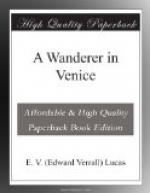Gondoliers can have pride: but there is no pride about a rampino, the old scaramouch who hooks the gondola at the steps. Since he too was once a gondolier this is odd. But pride and he are strangers now. His hat is ever in his hand for a copper, and the transference of your still burning cigar-end to his lips is one of the most natural actions in the world.
CHAPTER VIII
THE GRAND CANAL. I: FROM THE DOGANA TO THE PALAZZO REZZONICO, LOOKING TO THE LEFT
The river of Venice—Canal steamers—Motor boats—Venetian nobility to-day—The great architects—A desirable enactment—The custom house vane—The Seminario and Giorgione—S. Maria della Salute—Tintoretto’s “Marriage in Cana”—The lost blue curtain—San Gregorio—The Palazzo Dario—Porphyry—The story of S. Vio—Delectable homes—Browning in Venice—S. Maria della Carita.
To me the Grand Canal is the river of Venice—its Thames, its Seine, its Arno. I think of it as “the river.” The rest are canals. And yet as a matter of fact to the Venetians the rest are rivers—Rio this and Rio that—and this the canal.
During a stay in Venice of however short a time one is so often on the Grand Canal that a knowledge of its palaces should come early. For fifteen centimes one may travel its whole length in a steamboat, and back again for another fifteen, and there is no more interesting half-hour’s voyage in the world. The guide books, as a rule, describe both banks from the same starting-point, which is usually the Molo. This seems to me to be a mistake, for two reasons. One is that even in a leisurely gondola “all’ora” one cannot keep pace with literature bearing on both sides at once, and the other is that since one enters Venice at the railway station it is interesting to begin forthwith to learn something of the city from that point and one ought not to be asked to read backwards to do this. In this book therefore the left bank, from the custom house to the railway station, is described first, and then the other side returning from the station to the Molo.
The Grand Canal has for long had its steamers, and when they were installed there was a desperate outcry, led by Ruskin. To-day a similar outcry is being made against motor-boats, with, I think, more reason, as I hope to show later. But the steamer is useful and practically unnoticeable except when it whistles. None the less it was an interesting experience in April of this year (1914) to be living on the Grand Canal during a steamer strike which lasted for several days. It gave one the quieter Venice of the past and incidentally turned the gondoliers into plutocrats.
But there is a great difference between the steamers and the motor-boat. The steamer does not leave the Grand Canal except to enter the lagoon; and therefore the injustice that it does to the gondolier is limited to depriving him of his Grand Canal fares. The motor-boat can supersede the gondola on the small canals too. It may be urged that the gondolier has only to become an engineer and his position will be as secure. That may be true; but we all know how insidious is the deteriorating influence of petrol on the human character. The gondolier even now is not always a model of courtesy and content; what will he be when the poison of machinery is in him?




